Top speed 926 km/h Length 11 m Engine type Jet engine | Wingspan 12 m Retired 1958 First flight November 24, 1947 | |
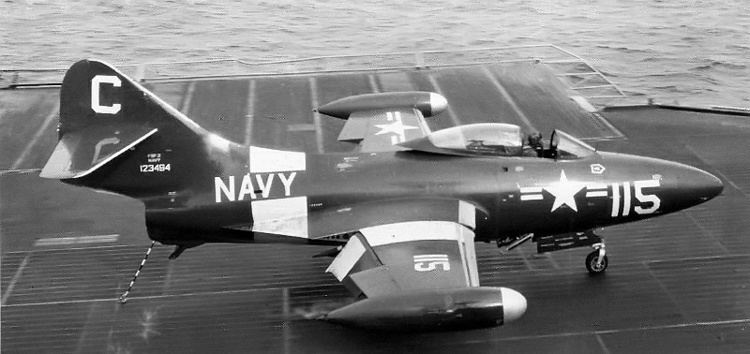 | ||
U s navy grumman f9f panther huge turbine rc model jet hausen 2016 flight day
The Grumman F9F Panther was the manufacturer's first jet fighter and one of the United States Navy's first successful carrier-based jet fighters. A single-engined, straight-winged day fighter, it was fitted with an armament of four 20 mm (0.79 in) cannons and could carry a wide assortment of air-to-ground munitions.
Contents
- U s navy grumman f9f panther huge turbine rc model jet hausen 2016 flight day
- Design and development
- US Navy
- Argentine Navy
- Variants
- Operators
- Argentina
- United States
- Specifications F9F 2 Panther
- References

The Panther was used extensively by the U.S. Navy and the United States Marine Corps in the Korean War. It was also the first jet aircraft used by the Blue Angels flight team, being used by them from 1949 through to late 1954. The aircraft was exported to Argentina and was the first jet used by the Argentine Naval Aviation.
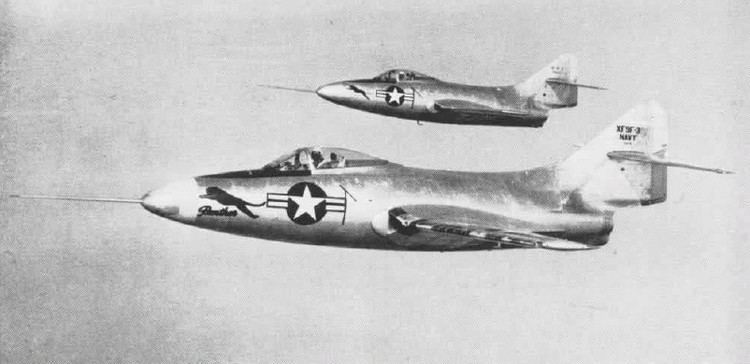
Total F9F production was 1,382. The design evolved into the swept wing Grumman F-9 Cougar.
Design and development
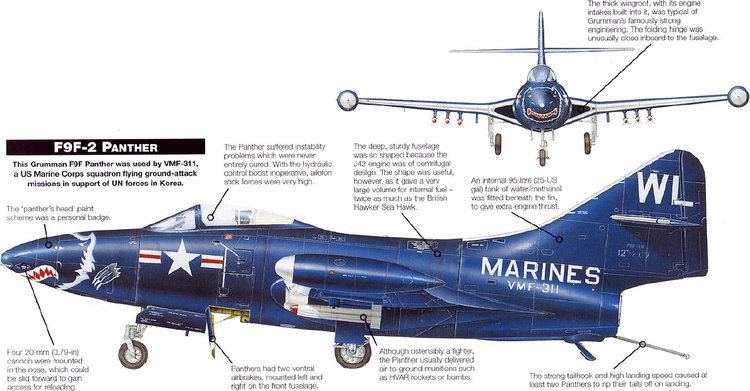
Development studies at the Grumman company for jet-powered fighter aircraft began near the end of World War II as the first jet engines emerged. In a competition for a jet-powered night fighter for the United States Navy, the Douglas XF3D-1 was selected over Grumman Aircraft Engineering Corporation's G-75 two-seat, four-Westinghouse J30-powered design, with Douglas being issued a contract on 3 April 1946. The U.S. Navy's Bureau of Aeronautics (BuAer) also issued a contract to Grumman for two Model G-75 experimental aircraft on 11 April 1946, being given the Navy designation XF9F-1, in case the Skyknight ran into problems.

Grumman soon realized the G-75 was a losing design but had been working on a completely different, single-engine day fighter known as the Grumman G-79. Due to some interesting bureaucracy, BuAer did not cancel the G-75 (XF9F-1) contract but changed the wording to include three entirely different G-79 prototypes. The G-79 became the Grumman F9F Panther.
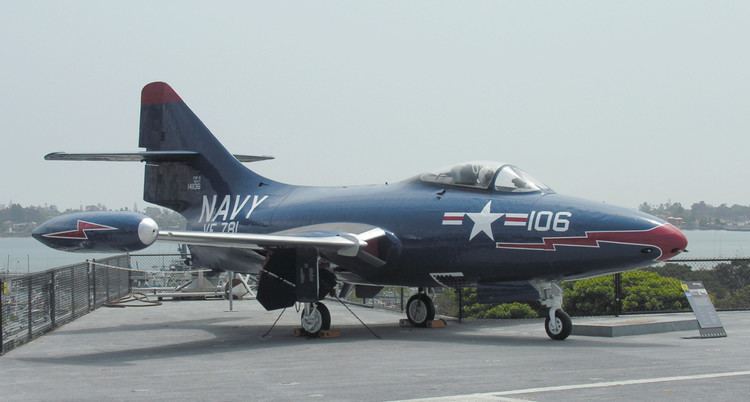
The prototype Panther, piloted by test pilot Corky Meyer, first flew on 21 November 1947. American engines available at the time included the Allison J33 and Westinghouse J34, but these were not considered sufficiently reliable, so the Navy specified the imported Rolls-Royce Nene turbojet, which was also more powerful at 5,000 lb. of thrust. Production aircraft would have a Nene engine built under license by Pratt & Whitney as the J42. Since there was insufficient space within the wings and fuselage for fuel for the thirsty jet, permanently mounted wingtip fuel tanks were added, which incidentally improved the fighter's rate of roll.
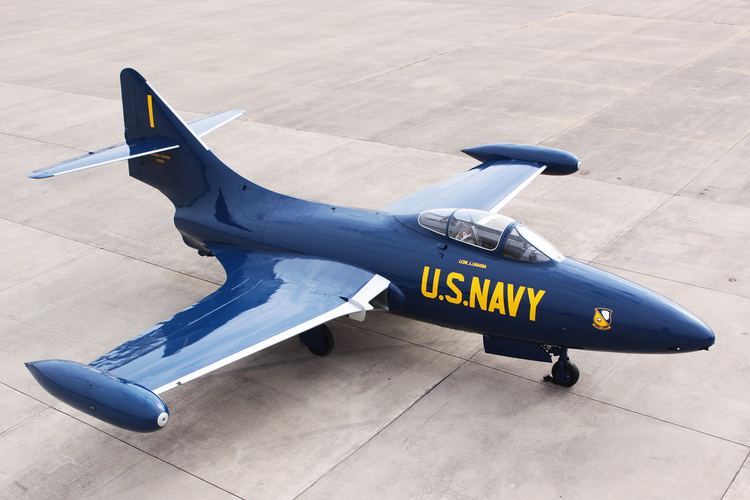
It was cleared for flight from aircraft carriers in September 1949. During the development phase, Grumman decided to change the Panther's engine, selecting the Pratt & Whitney J48-P-2, a license built version of the Rolls-Royce RB.44 Tay. The other engine that had been tested was the Allison J33-A-16. The armament was a quartet of 20 mm guns, the Navy having already switched to this caliber (as opposed to the USAAF/USAF which continued to use 12.7 mm M2/M3 guns). As well, the Panther soon was armed with underwing air-to-ground rockets and up to 2,000 lb (910 kg) of bombs.
From 1946, a swept-wing version was considered and after concerns about the Panther's inferiority to its MiG opponents in Korea, a conversion of the Panther (Design 93) resulted in a swept-wing derivative of the Panther, the F9F Cougar, which retained the Panther's designation number.
U.S. Navy
The Grumman Panther was the primary U.S. Navy and USMC jet fighter and ground-attack aircraft in the Korean War. The Panther was the most widely used U.S. Navy jet fighter of the Korean War, flying 78,000 sorties and scoring the first air-to-air kill by the U.S. Navy in the war, the downing of a North Korean Yakovlev Yak-9 fighter. F9F-2s, F9F-3s and F9F-5s, as rugged attack aircraft, were able to sustain operations, even in the face of intense anti-aircraft fire. The pilots also appreciated the air conditioned cockpit, which was a welcome change from the humid environment of piston-powered aircraft.
Despite their relative slow speed, Panthers also managed to shoot down two Yak-9s and seven Mikoyan-Gurevich MiG-15s for the loss of two F9Fs. On 3 July 1950, Lieutenant, junior grade Leonard H. Plog of U.S. Navy's VF-51 flying an F9F-3 scored the first U.S. Navy air victory of the war by shooting down a Yak-9.
The first MiG-15 was downed on 9 November 1950 by Lieutenant Commander William (Bill) Amen of VF-111 "Sundowners" flying an F9F-2B. Two more MiG-15s were downed on 18 November 1950. The final four MiG-15s were downed on 18 November 1952 by Lt. Royce Williams of VF-781, flying off the USS Oriskany during a series of air strikes against the North Korean port of Hoeryong, right across the mouth of the Tumen River from the major Soviet base at Vladivostok. Williams' victories were notable because all four were flown by Soviet Naval Aviation pilots.
In 1992, Russian authorities admitted that Captains Belyakov and Vandalov, and Lieutenants Pakhomkin and Tarshinov were lost on 18 November 1952. Information regarding this fight had been suppressed by the U.S. Navy at the time because personnel of the then-new National Security Agency had been involved in the intercept, and U.S. authorities were concerned that the Soviets might learn of this if the affair was publicized.
No other fighter pilot ever scored four MiG-15s in a single combat. Future astronaut Neil Armstrong flew the F9F extensively during the war, even ejecting from one of the aircraft when it was brought down by a wire strung across a valley, in 1951. Future astronaut John Glenn and Boston Red Sox all-star baseball player Ted Williams also flew the F9F as Marine Corps pilots.
Panthers were withdrawn from front-line service in 1956, but remained in training roles and with U.S. Naval Air Reserve and U.S. Marine Air Reserve units until 1958. The Navy's Blue Angels flight demonstration team used the Panther for four years, beginning in 1951. The Panther was the Blue Angels' first jet. Some Panthers continued to serve in small numbers into the 1960s. From September 1962 surviving operational Panthers were redesignated F-9 within the new combined US tri-service designation system.
Argentine Navy
The only foreign buyer of the Panther was the Argentine Naval Aviation, which bought 28 ex-USN F9F-2B aircraft in 1957; the first 10 arrived in 1958. Only 24 aircraft were put in service, the rest was used as spares. The first flight of an Argentine Panther was in December 1958, and the last aircraft was put in service in January 1961.
The catapults on the then only Argentine carrier, ARA Independencia, were considered not powerful enough to launch the F9F, so the aircraft were land-based. However, in July 1963 a Panther (serial 0453/3-A-119) landed on the Independencia as part of trials; becoming the first jet to land on an Argentine aircraft carrier.
Argentine Navy F9F-2 Panthers saw combat in the 1963 Argentine Navy revolt, bombing and strafing a column of the Army 8th Tank Regiment which was advancing on the rebelling Base Aeronaval Punta Indio (English: Punta Indio Naval Air Base). The attack destroyed several M4 Sherman tanks, at the cost of one F9F Panther shot down.
The Argentine Panthers were involved in the general mobilization during the 1965 border clash between Argentina and Chile but no combat occurred. They were taken out of service in 1969 due to the lack of spare parts and replaced with Douglas A-4Q Skyhawks.
The Argentine Navy also operated the F-9 Cougar.
Variants
Operators
Argentina
United States
Specifications (F9F-2 Panther)
Data from
General characteristics
Performance
Armament
